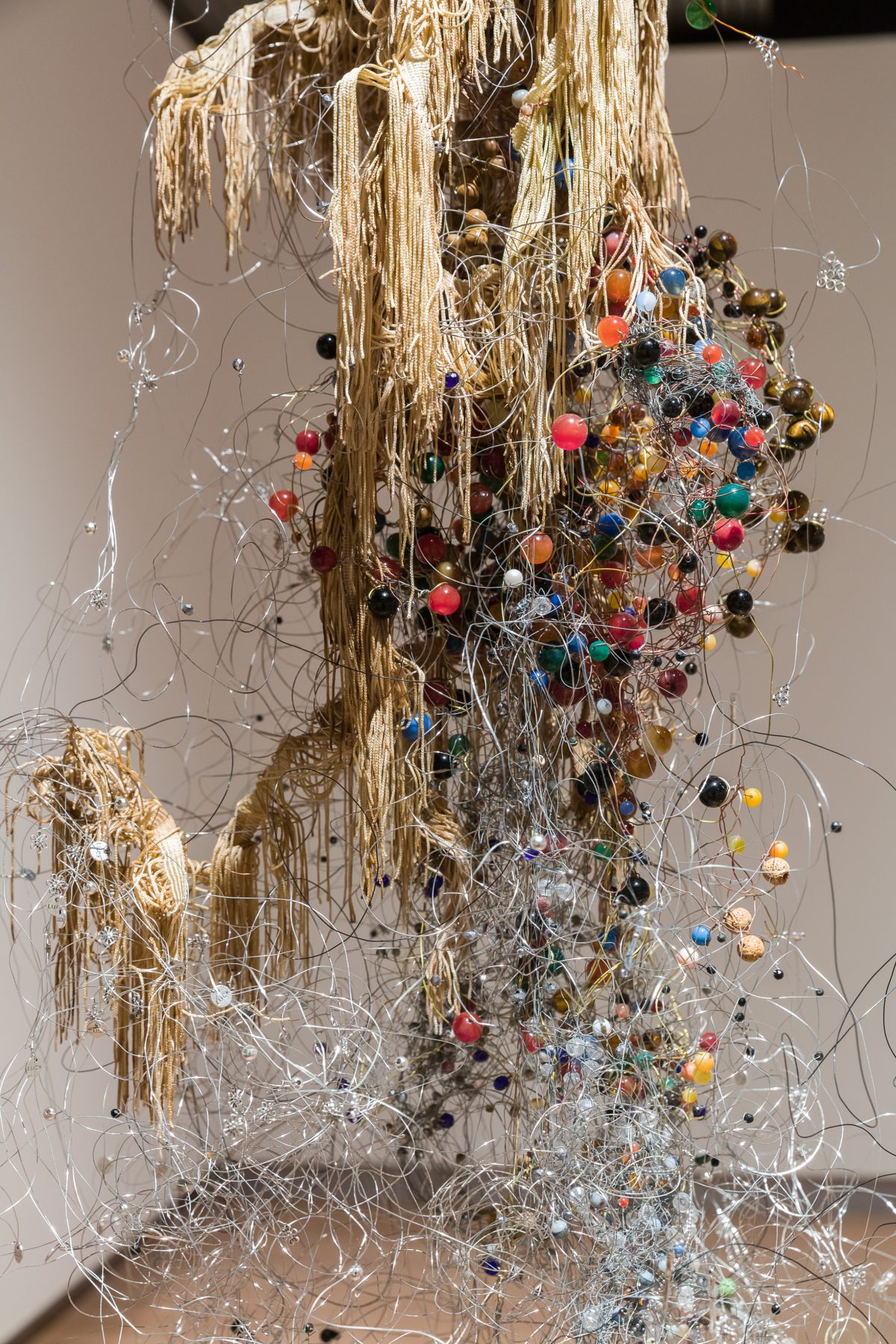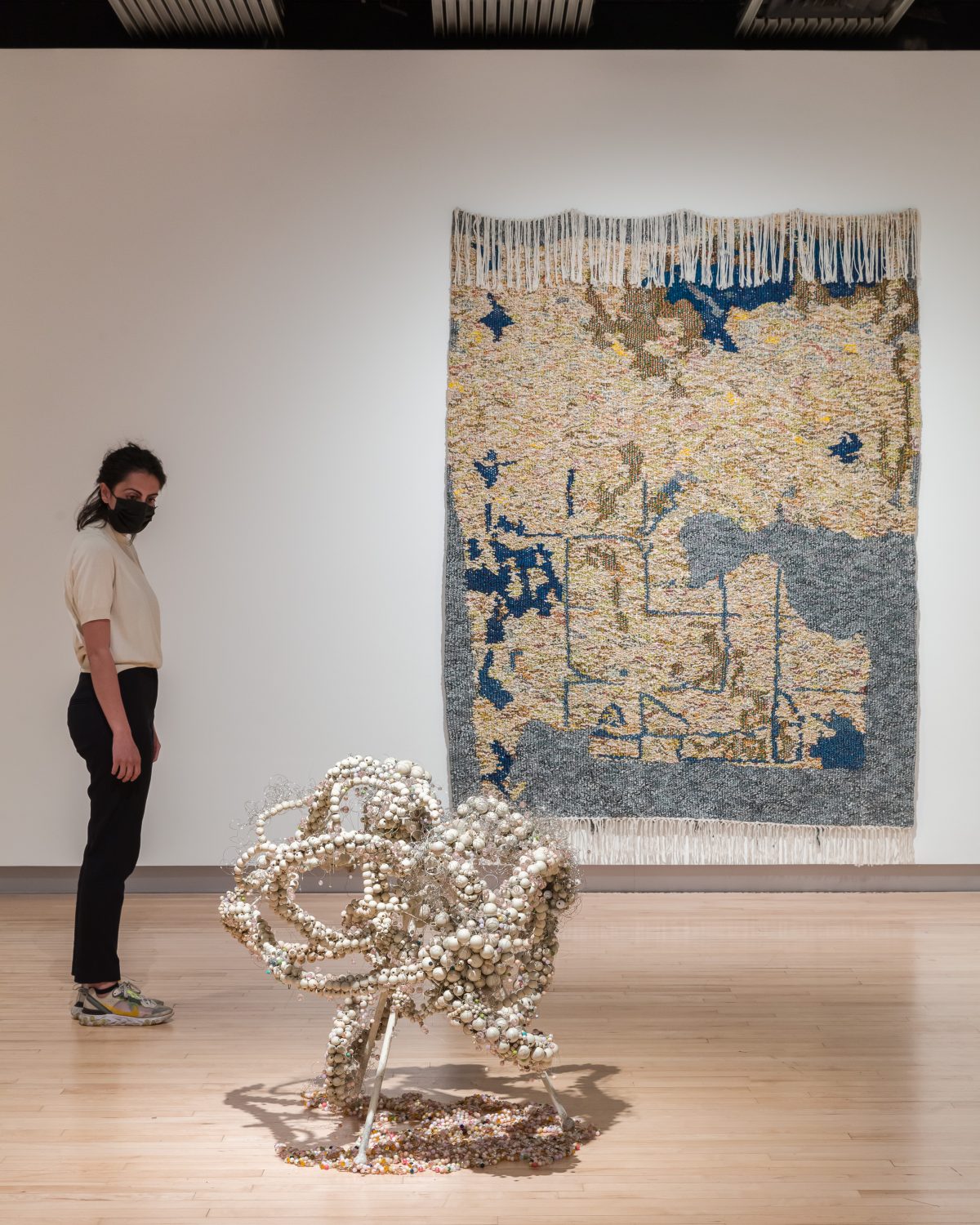
LONDON — Drama and dance materialize in knotty, tangled masses of beads and wire floating in the air at the Hayward Gallery. For his first solo exhibition in the UK, Kicking Dust, South African artist Igshaan Adams explores religion, race, and domestic life as sites of contestation and comfort through the craft of weaving. Contained within one large room, the exhibition employs floor, wall, and ceiling to display his woven textile works and hanging sculptures, which comprise an assemblage of materials — bead, rope, wire, steel, fabric, wood, and bone — from Cape Town, where the artist was born and currently lives and works. Made with the help of up to four women weavers as well as his family members, who are regularly involved in his practice, the work intimates a sense of community.

mixed media, variable dimensions (photo by Mark Blower)
“Kicking Dust”(2020), the focal work of the exhibition, is an installation of fine wire, tangled and twisted with beads into sinewy masses of “cloud” sculptures suspended over four fragments of fringed floor weaving. The work refers to an Indigenous courtship dance of the Northern Cape, where dancers unearth the sand as they dance, resulting in plumes of dust clouds moving around as they move. Within the weaving beneath, pathways or “desire lines” have been mapped out allowing you to walk between the weaving fragments. Here we find the center point the exhibition is gathered around; trails left by the existence of people in space — albeit private domestic space — larger communities, or in between.
The compositions of the wall hangings follow this line of thought similarly. In “Agter Om” (Afrikaans for “Around the Back”) (2020), the traces of the path tread by a family across a linoleum floor in their home in Bonteheuwel is realized in black, white, and turquoise beads intricately interwoven. Adams often mines his own personal history in his practice, revisiting his past. Bonteheuwel holds personal significance for the artist as an area of the Cape Flats where he grew up. “Om Die Hoek” (Around the Corner) (2020), a fringed tapestry of pale yellows and blues also highlights a passageway. This liminal space is imbued within all of the works — the transitioning to and from racially demarcated spaces, spiritual followings, and ethnicities.

Adams’s weavings are the kind that demand to be stood directly in front of, for you to hunker down on your knees, to crane your neck at all angles — to be touched even — in order to appreciate the intricacies of warp and weft, the color of the beads, and the breadth of materials. His hybrid identity — gay, of Cape Coloured descent (a heterogeneous South African ethnicity), working class, raised in a catholic household while practicing Islam and eventually finding Sufism — informs the conceptual backbone of the work. This complex standpoint is aptly reflected in the medium of weaving. The rope and threads act as a support, not only to the tapestries themselves but to make sense of his own tumultuous upbringing, growing up in a segregated community amid the violent history of Apartheid.
These tensions come all the more sharply into focus exhibited next to the Hayward’s Matthew Barney exhibition Redoubt, which you have to walk through to enter Kicking Dust. Barney’s large (phallic, even) cast trees, exhibited on assimilated missile launchers and tripods speak to a bold established practice, made of cold, hard materials. In proximity, the warmth and pliability of Adams’s textiles offsets Barney’s harsh and colorless work, emphasising its emotional qualities and collective makings. The works propose a moving-forward-together, coalescing Adams’s tangled identity with a kinship and connectedness that repair and sustain.

Igshaan Adams: Kicking Dust continues through July 25 at the Hayward Gallery (Belvedere Road, London SE1 8XX). The exhibition was curated by Tarini Malik.
0 Commentaires